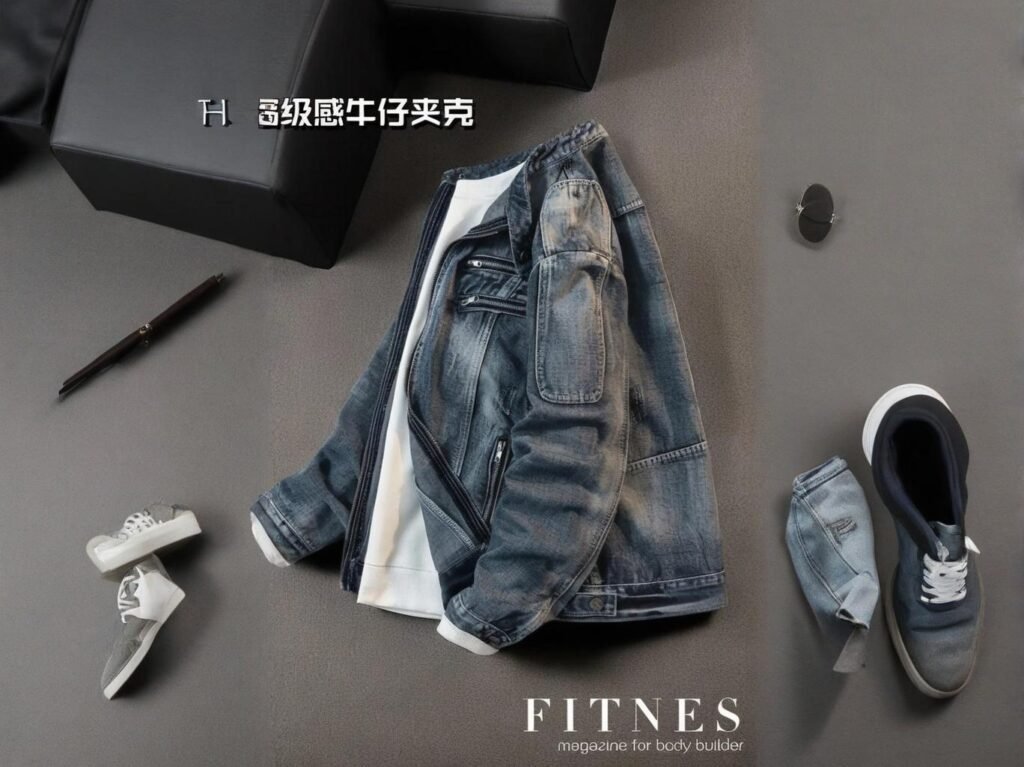
In the textile world, “denim” and “jeans fabric” are often used interchangeably—but they’re not the same shade in the wash. While denim refers to the classic cotton twill weave, jeans fabric encompasses finished, ready-to-stitch material that’s already been dyed or washed. Choosing the right fabric can make or break your garment’s performance, feel, and cost structure. Denim is the raw woven material, while jeans fabric is denim in its garment-ready form—dyed, finished, and sometimes blended with stretch fibers. Understanding this difference is key to ensuring you source materials that align with quality, wearability, and production timelines.
Imagine a small DTC brand based in Berlin: they ordered premium denim bolts expecting raw material. But when finished, the fabric came pre-washed and pre-shrunk—perfect for fast turnaround, but it blew their garment specifications. They learned the hard way: always verify if you’re buying denim or jeans fabric—your production plan depends on it. Want to avoid that pitfall? Let’s dig deeper.
What Is Denim Fabric and How Is It Made?
Denim is a sturdy cotton twill textile woven with a specific structure—traditionally blue warp and white weft. It’s the raw canvas from which garment-ready versions are derived. Denim fabric is woven from cotton yarn using a 3/1 or 2/1 twill, where the warp thread is twisted and colored (typically indigo) while the weft remains undyed. This construction gives denim its diagonal ribbing and durability.
Anatomy of Denim Fabric
1. Twill Structure Mechanics
- Warps go over-and-under wefts in a 3:1 or 2:1 ratio, creating visible diagonal lines.
- The density of the weave (ends and picks) determines weight and surface texture.
2. Fiber and Yarn Characteristics
- Classic denim uses ring-spun, long-staple cotton yarn to ensure strength and character.
- Many mills now offer blends with elastane (1–5%) for stretch, or recycled cotton for sustainability.
3. Fabric Weight (GSM/Oz)
- Varies widely—5 oz shirts up to 21 oz heavy selvedge.
- Weight affects drape, stiffness, wear patterns, and stitching technique.
4. Finishing Stages
- Raw denim is unwashed; it requires shrinkage and color handling during garment production.
- Special finishes—like sanforization, resin finish, or enzyme wash—are added later.
What Is Jeans Fabric and How Does It Differ from Denim?
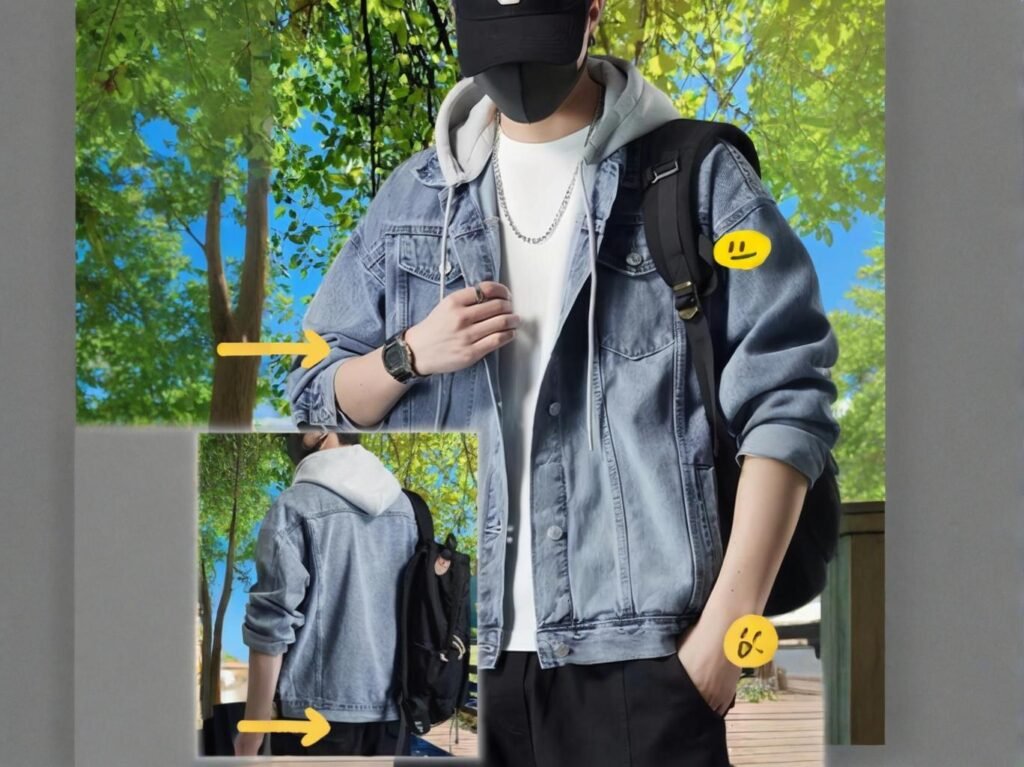
Jeans fabric has gone through finishing processes (dyeing, pre-shrinking, sanding) to become garment-ready. It’s what factories stitch into trousers without extra finishing steps. Jeans fabric refers to finished denim—that has been dyed, washed, pre-shrunk, or treated—ready for cutting and sewing. Whereas raw denim requires in-line processing, jeans fabric simplifies production and ensures consistent shrinkage rates.
Defining Jeans Fabric
1. Dye Types and Consistency
- Includes dyed rolls with specific shade depth and fastness levels.
- May be rinsed, enzyme-washed, or coated for handfeel and comfort.
2. Shrinkage Management
- Garment manufacturers rely on sanforized or pre-shrunk jeans fabric to prevent production surprises.
- Raw denim shrinkage (3–7%) must be accounted for in size blocks.
3. Surface Treatments for Wear and Feel
- Stone-wash, laser abrasion, resin, or softeners can be pre-applied.
- Addresses consumer demand for worn-in looks and tactile quality.
4. Stretch and Handle
- Jeans fabric often includes stretch fibers and softening finishes to improve wearability.
- Raw denim lacks these attributes and feels stiffer straight off the loom.
What Is Denim Fabric and How Is It Manufactured?
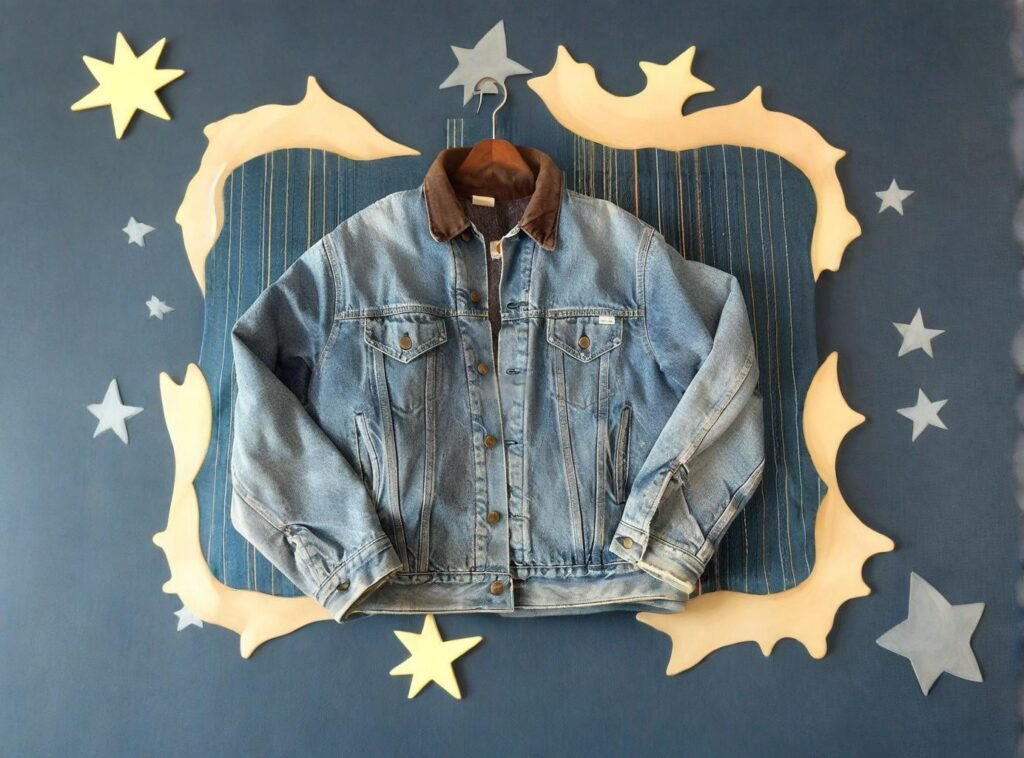
Denim is a woven cotton twill textile, known for its diagonal ribbing and durable structure. It’s most often dyed with indigo on the warp yarns and left white on the weft, creating the iconic two-tone appearance. The fabric is created through a weft-under-warp weaving process, giving denim its unique strength and texture. Denim is a durable twill weave fabric typically made from cotton, characterized by a blue warp and white weft yarn, making it ideal for heavy-duty fashion applications like jeans and jackets.
Key Aspects of Denim Fabric Manufacturing
1. Twill Weaving Process Twill creates the diagonal pattern:
| Type | Description |
|---|---|
| 3/1 Twill | Three warp yarns over one weft – common in jeans |
| 2/1 Twill | Two over one – lighter denim, used in shirts |
2. Indigo Dyeing Techniques Denim’s color is achieved through rope dyeing or slasher dyeing:
- Rope Dyeing: Better color penetration, used by premium mills.
- Slasher Dyeing: Faster and more economical.
3. Fiber Composition While traditional denim is 100% cotton, modern variants include:
- Elastane: for stretch denim
- Recycled cotton or polyester: for sustainability
4. Finishing Techniques
- Sanforization: pre-shrinks the fabric
- Mercerization: enhances dye uptake
- Stone Washing: softens the fabric and gives a vintage look
Cone Denim (USA) pioneered open-end denim spinning, while Pakistan’s Artistic Milliners is known for laser finishing with reduced water and energy use.
What Is Jeans Fabric and How Does It Differ from Denim?
Jeans fabric is often confused with denim, but technically refers to the end-use textile created specifically for jeans garments. While jeans are usually made from denim, the term “jeans fabric” encompasses other compositions and finishes tailored to pants manufacturing. Jeans fabric refers to materials—primarily denim but also including stretch blends and coatings—specifically optimized for making jeans. It focuses on performance, comfort, and garment-specific finishes.
Distinguishing Jeans Fabric from Denim
1. Fabric Purpose
| Feature | Denim | Jeans Fabric |
|---|---|---|
| Definition | The raw woven textile | Fabric prepped for jeans manufacturing |
| Focus | Structure and durability | Comfort, stretch, fit, and style |
2. Stretch and Recovery Most jeans fabrics today include:
- 1–3% elastane or Lycra
- Bi-stretch options for women’s skinny jeans
3. Coated and Treated Textures Jeans fabric often includes:
- Wax-coated finishes (for shine)
- Sandblasting, whiskering, laser fading
4. Functional Additives For workwear or high-performance jeans:
- Water-repellent treatments
- Anti-microbial coatings
5. Mass Customization Jeans fabrics are customized for brands’ fits and fashion cycles, unlike raw denim which is more generic.
Levi’s partners with ISKO for soft, stretch-enhanced jeans fabrics that retain a premium denim aesthetic.
Which Manufacturing Processes Influence Denim vs Jeans Fabric Quality?
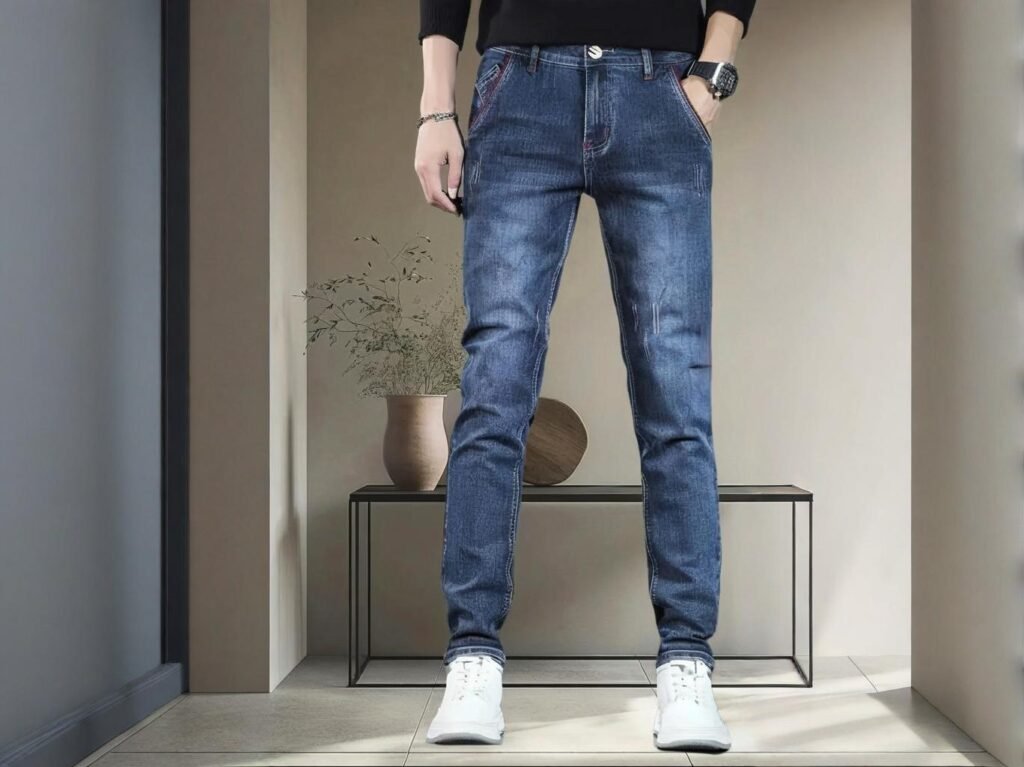
The quality of both denim and jeans fabric depends not only on raw materials but also on intricate manufacturing processes that determine weave strength, dye retention, finish quality, and stretch resilience. While denim focuses on foundational textile durability, jeans fabric undergoes additional processes to align with fashion, function, and fit. Key manufacturing steps like yarn spinning, indigo dyeing, weaving, sanforization, and garment-finishing techniques directly affect the texture, durability, and performance of both denim and jeans fabric. Jeans fabric often includes extra steps like enzyme washing, laser finishing, or resin coating for added fashion value.
Critical Steps That Impact Fabric Quality
1. Yarn Spinning Methods
| Type | Description | Effect on Quality |
|---|---|---|
| Ring Spun | Traditional method with soft hand-feel | High durability, luxury look |
| Open-End Spun | Faster and more economical | Coarser texture, lower cost |
| Core-Spun (for jeans) | Spandex or polyester core for stretch | Improved flexibility |
2. Indigo Dyeing Process
- Number of dips directly impacts color fastness (e.g., 6–12 dips for deep indigo).
- Fixation methods (oxidation vs. air exposure) enhance fade resistance.
3. Fabric Weaving
- Tightness of twill weave influences strength and breathability.
- 3/1 weaves are common in rugged denim, while 2/1 is used for lighter jeans.
4. Pre-Finishing Treatments
| Treatment | Benefit |
|---|---|
| Sanforization | Shrink-resistance and stability |
| Mercerization | Improved dye uptake |
| Singeing | Smoother surface for printing |
5. Jeans-Specific Post-Finishes
- Enzyme wash: breaks down fiber surface for softness.
- Laser distressing: eco-friendly, creates worn-in look.
- Resin coating: adds rigidity and a leather-like sheen.
Candiani Denim (Italy) uses foam dyeing and Kitotex® technology to reduce water use by over 75%, proving how tech innovations affect both denim and jeans fabric quality.
How Do Weight, GSM, and Durability Compare Between the Two?
Weight and durability are key factors for garment manufacturers when choosing between denim and jeans fabric. While denim is usually classified based on GSM (grams per square meter) or ounces per square yard, jeans fabric is fine-tuned to fit end-user requirements such as comfort, stretch, and trend responsiveness. Denim is available in a broad GSM range (6 oz–20 oz), and its weight correlates with durability. Jeans fabric, although often derived from denim, is more nuanced—lightweight jeans prioritize flexibility, while heavyweight options offer ruggedness. Blended fibers often reduce GSM without compromising performance.
Denim and Jeans Fabric GSM Comparison
1. Weight Classification Table
| Weight (oz/sq yd) | GSM Range | Usage Example |
|---|---|---|
| 6–9 oz | 200–300 GSM | Summer jeans, shirts, dresses |
| 10–13 oz | 300–440 GSM | Standard jeans, jackets |
| 14–16 oz | 440–540 GSM | Workwear, rigid raw jeans |
| 17–20 oz | 580–680 GSM | Selvedge denim, high-durability gear |
2. Fabric Durability Factors
- Denim: High weave density = abrasion resistance.
- Jeans Fabric: May sacrifice some durability for softness/stretch.
3. Stretch vs. Non-Stretch Impact
- A 10 oz non-stretch denim is generally more durable than a 10 oz stretch denim due to elastane’s degradation over time.
4. Durability Testing Metrics
| Test Type | Description | Ideal Score |
|---|---|---|
| Martindale Abrasion | Simulates fabric wear over time | >20,000 cycles |
| Tear Strength | Measures resistance to tearing force | >15 N |
| Recovery Test | Checks elasticity return in stretch denim | >90% recovery |
Many fashion brands now prefer 10–12 oz jeans fabric for its ideal balance of weight, drape, and comfort—especially for slim and tapered cuts.
Are There Sustainable and Recycled Denim or Jeans Fabric Options?
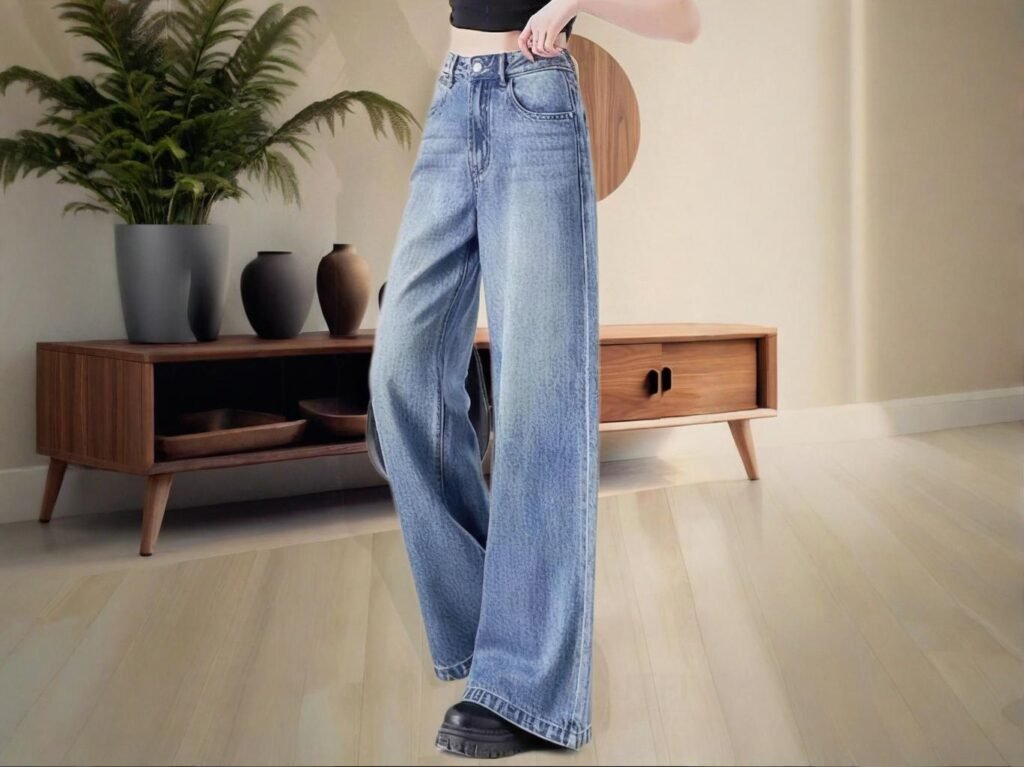
Yes, both denim and jeans fabric can be produced sustainably using organic cotton, recycled fibers, and water- and energy-saving processes. In recent years, B2B buyers have increasingly demanded eco-conscious materials to meet consumer preferences and ESG requirements. Sustainable denim and jeans fabric options include GRS-certified recycled cotton, post-consumer waste blends, and fabrics processed using laser, ozone, and foam dyeing. These reduce water usage by up to 90% and chemicals by 70%, with brands like Levi’s, Nudie Jeans, and SzoneierFabrics leading the transformation.
Exploring Sustainable Denim Solutions
1. Types of Sustainable Materials
| Type | Description | Certification |
|---|---|---|
| Organic cotton | Grown without pesticides | GOTS, OEKO-TEX |
| Recycled cotton | Made from pre/post-consumer waste | GRS, RCS |
| Recycled polyester blend | Often from PET bottles | GRS, Bluesign |
| Hemp or lyocell blends | Strong, fast-growing, biodegradable | USDA Organic |
2. Eco-Friendly Production Techniques
- Laser fading instead of sandblasting for distressed looks
- Ozone washing eliminates water waste in stonewash effects
- Foam dyeing replaces water-heavy indigo vats
3. Global Examples
- Saitex (Vietnam): A LEED-certified factory using 98% recycled water
- Arvind Mills (India): Produces “Zero Liquid Discharge” denim
- SzoneierFabrics (China): Offers recycled jeans fabric at low MOQs with GRS certification
4. Impact Metrics
| Indicator | Traditional Denim | Eco Denim |
|---|---|---|
| Water Use (L/jean) | 1,500–2,000 | < 200 |
| Energy (kWh/jean) | 4–6 | < 2.5 |
| CO₂ Emissions | \~33 kg CO₂ | \~10–15 kg CO₂ |
Nudie Jeans claims 98.5% of its products use sustainable fibers, with denim lines made of 100% organic or recycled cotton.
How Do You Choose the Right Fabric for Specific Garment Applications?
Choosing between denim and jeans fabric comes down to understanding the garment’s purpose, fit, performance, and aesthetic. Manufacturers must consider fabric GSM, stretch properties, weave density, and finishing options to align with design needs. For workwear or outerwear, heavyweight rigid denim (14–16 oz) offers durability. For fashion-forward, comfort-focused pieces, jeans fabric with stretch and lighter GSM (10–12 oz) is ideal. Functional attributes like breathability, dye retention, and recovery are key determinants.
Matching Fabric Type to Apparel Use
1. Apparel Type vs. Fabric Recommendation
| Garment Type | Recommended Fabric Type | Reason |
|---|---|---|
| Jeans (classic cut) | 12–14 oz rigid denim | Structure, longevity |
| Skinny jeans | 10–12 oz stretch jeans fabric | Flexibility, comfort |
| Denim shirts | 6–8 oz soft washed denim | Light, breathable |
| Denim jackets | 12–16 oz heavyweight denim | Warmth, rugged look |
| Kids’ wear | 8–10 oz stretch jeans fabric | Soft, easy to move in |
2. Questions to Ask Before Choosing
- Will the fabric shrink or stretch after wash?
- Is GSM compatible with the design cut?
- How will it perform under abrasion or moisture?
3. Data-Driven Testing Benchmarks
| Performance Area | Ideal Metric |
|---|---|
| Shrinkage (%) | < 3% after 3 washes |
| Stretch Recovery (%) | > 90% after 5 cycles |
| Fade Resistance | 4–5 grade (AATCC Grey Scale) |
SzoneierFabrics allows fashion brands to request free sampling for custom denim blends based on their technical requirements and target market preferences.
Call to Action: Let SzoneierFabrics Help You Customize Your Fabric
At SzoneierFabrics, we help brands and manufacturers around the world bring their denim visions to life. Whether you’re sourcing heavyweight selvedge, stretch jeans fabric, or recycled blends, we offer:
- Low MOQ custom orders starting from 50 meters
- Free design support and sample delivery
- Short lead times and 100% quality assurance
Let’s build your next denim collection with premium, personalized fabric solutions.

